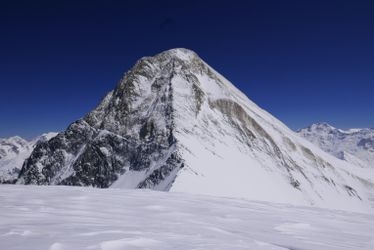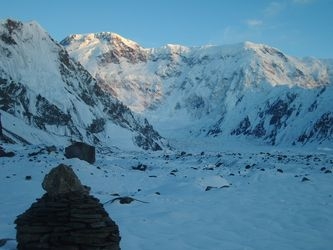Why climb in Kyrgyzstan
Kyrgyzstan, with its towering Tien Shan range, is a paradise for high-altitude mountaineers seeking both technical challenges and remote, pristine landscapes. The country is home to peaks like Khan Tengri (7,010 m) and Pobeda Peak (7,439 m), which are renowned for their demanding ascents and breathtaking views. For experienced climbers, Kyrgyzstan offers some of the most exhilarating mountaineering routes in Central Asia, combining rugged terrains with stunning alpine scenery.
When to climb in Kyrgyzstan
- July and August
The best time to climb in Kyrgyzstan is typically from July to August, when the weather is relatively stable and conditions are most favorable. However, the high-altitude Tien Shan range is notorious for its unpredictable weather, with rapid temperature drops and sudden storms. Khan Tengri, with its exposed ridges, is particularly sensitive to high winds, while Pobeda Peak requires careful timing to avoid dangerous conditions. Due to the extreme weather, preparation and flexibility are essential for climbers attempting these peaks.
Where to climb in Kyrgyzstan
The primary region for mountaineering in Kyrgyzstan is the Tien Shan Mountains, specifically around the Inylchek Glacier:
- Khan Tengri: Known as the “Lord of the Skies,” Khan Tengri is a pyramid-shaped peak with steep faces and challenging routes. Located on the border between Kyrgyzstan and Kazakhstan, it is one of the most beautiful and iconic mountains in the Tien Shan. Climbing Khan Tengri requires technical skill and experience with high-altitude conditions, as the peak is known for its rapidly changing weather.
- Pobeda Peak (Victory Peak): Pobeda is the highest mountain in the Tien Shan range and one of the most demanding climbs in the world. Its long, steep ridges and harsh conditions make it a true test of endurance and mountaineering skill. Located near the border with China, Pobeda’s remote setting and brutal conditions have earned it a reputation as one of the most challenging 7,000m peaks.
Climbs in Kyrgyzstan
Most popular
The classic climbs in Kyrgyzstan:
Most difficult
If you want to challenge yourself, consider these climbs in Kyrgyzstan:
All climbs in Kyrgyzstan
Khan Tengri, standing at a formidable 7,010 meters, is a revered challenge among mountaineers. Nestled at the tri-junction of Kazakhstan, Kyrgyzstan, and China, this peak is distinguished by its unique marble-pyramid shape that glistens under the sun, earning its name, which translates to "Lord of the Spirits." Its location in the Tien Shan mountains offers a climb that is both technically demanding and scenically rewarding. The mountain's sheer faces and unpredictable weather conditions demand respect and preparation, as sudden storms can transform a promising day into a test of skill and resolve.
The ascent of Khan Tengri is not for the faint-hearted. The mountain's difficulty stems from its varied climbing conditions, which range from steep ice and rock faces to expansive snowfields. Routes like the classic Northern Route from Inylchek Glacier are among the most traveled, yet they still pose significant challenges with sections that require adept use of ice axes and crampons. Acclimatization plays a crucial role in the success of the climb, given the high altitude and potential for altitude sickness. The mountain demands a high level of fitness and technical climbing proficiency, making it a proving ground for experienced alpinists.
While the allure of Khan Tengri's summit is undeniable, it's essential to approach with a clear strategy and respect for the mountain. Its remoteness adds to the isolation, and climbers must be self-sufficient, though there are 7 guides offering expeditions to assist those seeking local expertise. This mountain remains a testament to the beauty and challenge of high-altitude climbing, offering a rewarding experience for those prepared to meet its demands.
Pobeda Peak, or Jengish Chokusu, stands as the highest point in Kyrgyzstan at an imposing 7,439 meters. Its reputation among mountaineers is well-earned; this is not a climb for the faint-hearted. The mountain is known for its challenging weather conditions, with sudden storms and severe winds being a frequent occurrence. The route demands not only physical endurance but also technical proficiency, particularly when navigating the notorious ice walls and crevasses. The ascent often involves long, demanding traverses, and climbers should be prepared for abrupt temperature changes that can test even the most seasoned of alpinists.
Approaching the climb, you'll find that Pobeda Peak offers a unique challenge due to its location and the nature of its terrain. The South Inylchek Glacier provides the most common route to the summit, and it's a path that requires a deep respect for the mountain's unpredictable nature. Avalanches pose a real threat, and the snowpack can be treacherous. Those who have tackled it know that the mountain demands strategic planning and a keen awareness of the environment. Each section of the ascent presents its own hurdles, from navigating steep ice pitches to enduring the bitter cold of high-altitude camps.
For those considering the climb, the allure of Pobeda Peak lies in its raw, untamed beauty and the sense of accomplishment that comes with reaching the summit. It is a journey that tests your limits and demands resilience. The remoteness of the area adds an extra layer of complexity, making it essential for climbers to be self-sufficient and well-prepared. While there are seven guides offering expeditions up this formidable peak, the mountain requires a certain self-reliance and respect that only experienced mountaineers will fully appreciate. Each ascent is a story of its own, etched in the icy heights of Kyrgyzstan's tallest mountain.
Climb difficulties in Kyrgyzstan
How many of each difficulty grade can you find a route for.
| French Alpine | Difficulty description | Quantity |
|---|---|---|
| F | Easy. Suitable for beginners, minimal technical skills required. | 0 |
| PD | Not very difficult. Some technical skills required, with moderate exposure. | 0 |
| AD | Fairly difficult. Requires good technical skills and experience, with significant exposure. | 0 |
| D | Difficult. Requires advanced technical skills and experience, with high exposure. | 1 |
| TD | Very difficult. Requires very advanced technical skills, experience, and serious commitment. | 1 |
| ED | Extremely difficult. Requires exceptional technical skills, experience, and high commitment. | 0 |
Guides with trips in Kyrgyzstan
There are 14 guided trips listed for Kyrgyzstan. Trips range from $1,700 to $12,688, and average $3,153 per expedition.




